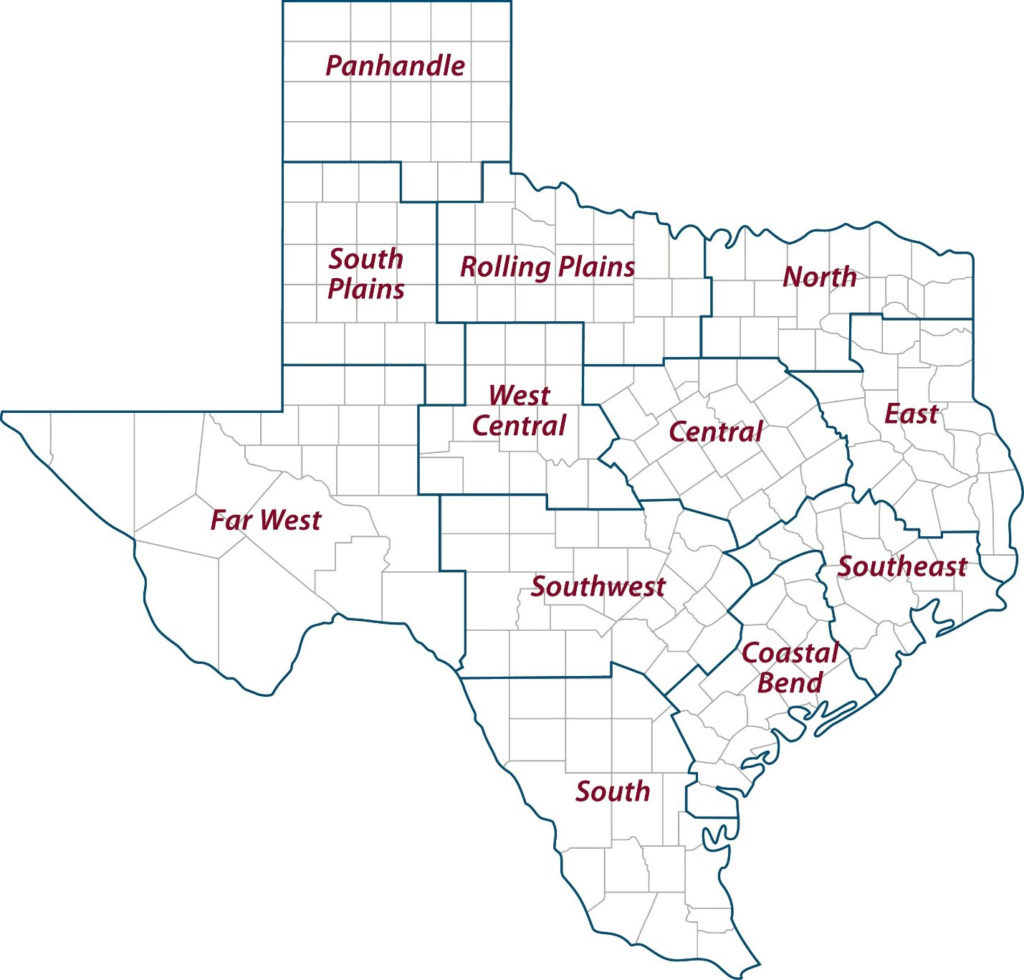Texas Crop and Weather Report
Thanks to timely spring rains and relatively mild summer temperatures, hunters have reason to be optimistic as they take to the field this fall, according to a Texas A&M AgriLife Extension Service expert.
Timely spring rains and relatively mild summer temperatures set the stage for abundant forage and vegetative cover supporting multiple wildlife species ahead of the fall hunting season. (Courtney Sacco/Texas A&M AgriLife)
Although portions of the Trans Pecos, Edwards Plateau and South Texas Plains continue to experience some form of drought, more than 60% of the state is drought-free, according to the U.S. Drought Monitor.
“Whenever we have sufficient spring and early summer rains, we tend to see really good recruitment, leading to population growth across most species,” said Marcus Blum, Ph.D., AgriLife Extension wildlife specialist and assistant professor in the Texas A&M College of Agriculture and Life Sciences Department of Rangeland, Wildlife and Fisheries Management.
These rains facilitate the growth of vegetation, which not only provides nutrition, but critical protection for nesting, brooding, fawning and thermal cover from the summer heat.
Dove populations trend upward
The season kicks off soon for dove hunters, and based on the latest Texas Parks and Wildlife Department Dove Population Status, they can anticipate good potential for a productive year.
Texas Parks and Wildlife biologists estimate the state supports 35.9 million mourning doves — a 5% increase from 2024 and 28% above the long-term average.
The estimates for mourning doves in the Central Mixed Grass Prairie in the Rolling Plains and the Tamaulipan Brushlands Bird Conservation Regions in the southern part of Texas also saw record highs.
This year, white-winged doves number around 11.7 million — an 8% decrease from 2024, but still 15% above the long-term population average.
Conditions good for white-tailed deer
With a population of roughly 5 million, Texas is home to more white-tailed deer than any other state. And thanks to mostly positive environmental conditions during gestation and fawning periods, Texans should expect to see many new, healthy additions to the landscape, Blum said.
“Something that is often overlooked is the importance of maternal condition on fetal development in white-tailed deer,” he said. “If the doe is in good condition, she will be able to allocate more energy into developing a stronger, healthier fawn.”
Blum said studies have shown health and nutrition during gestation has lasting impacts throughout the life of a fawn, including future body size and antler production.
“Lactation is also an extremely demanding time in terms of nutrition, so it is important that does have access to quality forage to support their health and that of their fawn,” Blum said. “I think many will be in good shape this year.”
Adequate nutrition is also critical for antler development.
“Bucks depend heavily on high-quality forage during the summer months — particularly plants rich in protein, calcium and phosphorus,” he said. “Although forage availability varied by region, I think we can anticipate solid antler growth in most parts of the state this year.”
Quail outlook positive
Over the last three decades, Texas has experienced a steady decline in both bobwhite and scaled quail populations, driven by several factors, including habitat loss and fragmentation of native grasslands they depend on.
Despite this downward trend, the last few years have seen productive nesting seasons for bobwhite quail, aided in large part by positive weather conditions supporting nesting cover and food availability.
“It looks like the bobwhite population in the Rolling Plains is going to be very good this year,” said Ryan O’Shaughnessy, Ph.D., executive director of the Rolling Plains Quail Research Foundation. “We’ve had great rainfall, and all of our surveys suggest we’re going to be in another boom year — probably pretty close to where we were in 2016.”
O’Shaughnessy said he anticipates a similarly positive outlook for the South Plains.
Although portions of the Trans Pecos have received some relief from extreme drought, it hasn’t been enough to support a rebound in scaled quail populations.
“The region has been so dry for so long that even if the scaled quail had a really good nesting season, they’re entering a very low breeding population,” O’Shaughnessy said. “There might be a slight bump, but I don’t know that it’s going to be as good as everyone is hoping for.”
Turkeys see stable or increasing population trends
According to Texas Parks and Wildlife biologists, observations of two or more poults per hen during annual surveys suggest a growing population. The 2024 Summer Turkey Survey documented 2.66 poults per hen.
“We’re seeing stable or increasing trends in Rio Grande turkey recruitment, and given the summer rains parts of the state received, I anticipate the productive spring turkey season will translate into fall as well,” Blum said.
Habitat management is key to supporting wildlife populations
While much of the state fared relatively well in terms of timely rains, Blum said regular precipitation is only part of the equation, and quality habitat management is necessary to allow that rainfall to translate into high-quality forage that meets the needs of Texas’ various game animals.
“Managing the landscape to meet the habitat needs of your desired species is going to weigh on the results,” he said. “Widespread land use and land management changes have hit many of our game bird species hard. For us as landowners and hunters, to conserve our game and non-game species, we need to steward the land that supports them.”
AgriLife Extension district reporters compiled the following summaries:
Panhandle
The district experienced hot, dry conditions, with overall soil moisture levels from short to adequate. Overall, crop conditions were reported as fair to good. Corn silage was being harvested, with grain corn to follow. Sorghum was progressing well and had reached full grain head growth. Progress in cotton was limited in many areas due to loss from early season hail damage. Producers were reporting some insect pressure. Pasture and range conditions were fair to good.

South Plains
The district experienced spotty, light showers, but not enough to prevent producers from working their fields. Subsoil and topsoil moisture levels were short due to a lack of precipitation and very high temperatures. Peanuts and cotton were at the end of their bloom. Peanut pods should continue to form over the next few weeks. Sorghum was maturing and starting to be harvested along with corn. Cattle and pastures were in good condition.
Rolling Plains
Scattered rainfall occurred in some areas, with totals ranging from a few tenths up to 1.5 inches, but conditions were mostly dry across the district. Weather allowed for tillage and preplant fertilizer applications ahead of wheat planting. Moisture helped pastures and improved overall crop conditions. Producers were actively preparing for winter wheat planting with rain in the forecast. Cotton crops experienced mixed conditions, but were generally healthy, although boll development was behind schedule due to late planting. Peanut crops were still pegging, and upcoming milder weather and rain chances should benefit their development. Hay production was strong, especially in areas with early-season rain and cooler summer temperatures. However, surplus supplies resulted in extremely low prices and low demand. Water tanks could use more rain heading into winter. Pastures were holding up well for August, and most counties reported good forage availability and strong livestock conditions.
North
Conditions were hot, humid and dry for the most part, with some areas catching a scattered shower. Topsoil and subsoil moisture levels were short to adequate across the district. Crops were in good condition overall. Corn was still being harvested with strong yields reported. Livestock conditions were good, and pastures looked incredible for this time of the year. Hay harvest was in full swing.
East
Rainfall was sporadic across the district. Subsoil and topsoil conditions were adequate. Pasture and rangeland conditions were fair to good. Grass and hay generally appeared abundant; however, some first hay cuttings were poor quality. Some producers had harvested so much hay that they were debating whether to plant winter pastures. Livestock were in fair to good condition, and cattle markets remained strong. Armyworms and Bermuda grass stem maggots were reported in pastures.
Far West
Temperatures were well above average with no measurable rainfall in eastern portions of the district. Scattered showers across the west tempered the impacts of prevailing hot and windy conditions. The cotton crop looked healthy with minimal pest pressure; however, it had begun to lose yield potential as bolls were beginning to set. Corn and sorghum matured and needed a little more time to dry down before harvest. Melon harvest was mostly complete, and most fields were not producing enough to justify harvest crews. Alfalfa looked good, but recent rainfall encouraged weeds and grass to grow. Pecans made good progress and were filling nicely. Insecticides were being applied to combat pecan weevils. Pastures dried up significantly, and cattle were starting to lose condition, leading to more supplemental feeding.
West Central
Conditions were hot and dry. There were a few short, scattered showers, but not enough to impact dry soil conditions. Row crops were suffering from heat and moisture stress. Cotton was maturing and nearing cutout. Corn was harvested, and sorghum was being harvested as fields matured. Pecan orchards under irrigation were in excellent condition. Fields were being prepared for fall wheat and small grain planting. Hay cutting and baling was underway, with some fields supporting third and fourth cuttings. Forage production slowed, but overall, pasture and range conditions were good for this time of year. Cattle conditions and the cattle market were good.
Southeast
Precipitation varied across the district, with soil moisture levels ranging from adequate to surplus. Crops were generally in good condition, with corn reaching maturity and the rice harvest almost complete. Sorghum had headed and matured, and cotton began to set bolls and square. Pasture and rangeland conditions ranged from fair to excellent. Livestock conditions were good overall.
Southwest
Cooler temperatures arrived. High winds were reported in the middle of the week, but damage was minimal. Precipitation averaged 1 inch for the week, and soil moisture was good. Sorghum harvest was completed, and corn harvest was wrapping up. Other row crops were being harvested as well. Pecan crops looked good, but more rain was needed for the nuts to fill. Elevated temperatures continued to stress pastures and rangelands, and all hay work was at a standstill. Supplemental feeding of livestock resumed, and livestock markets were steady. Breeding season should begin soon. Deer and other wildlife were in mostly good condition.
Coastal Bend
High temperatures and limited moisture continued to dry soils, and scattered showers provided little relief. Rice harvest was complete with fair to good yields reported. Corn harvest was wrapping up, with variable yields and some quality issues reported. Cotton harvest was progressing well with reports of above-average yields. Cotton gin yards were full, and most acres should be harvested within the week. Haying slowed, though scattered rains may help some regrowth. Range and pasture conditions continued to decline, with forage quality diminishing, and armyworms and mealybugs present in some areas. Livestock remained in fair to good condition, though some herds showed stress, and supplemental feeding began. Cattle marketing continued, supported by strong market conditions.
South
Conditions were hot and extremely humid with periodic showers. Topsoil and subsoil conditions were very poor in some areas. Fieldwork for strawberries continued, and vegetable producers harvested squash and okra. A few late-planted grain sorghum fields should be harvested over the week. Most cotton was harvested, but some fields were still blooming and progressing under irrigation. Sunflowers were almost ready for harvest, and some producers were preparing fields for fall vegetable planting. Cabbage conditions were fair. Pecan trees looked green, but another low production year was anticipated. Peanut crops continued to progress under irrigation. Sesame harvest continued with above-average yields reported. Range and pasture conditions declined, and some counties implemented burn bans. Some livestock producers were culling herds and providing supplemental feed to maintain good body condition scores. Beef cattle prices remained high, and supplies remained low. Wildlife were in good condition overall, with deer producers providing supplemental feed.








